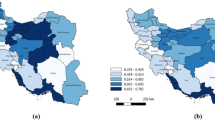Abstract
China’s energy consumption and environmental problems are becoming increasingly urgent issues as the nation’s economy continues its rapid development. A further investigation of ecological efficiency would assist the healthy development of China’s “coal cities.” In this study, the stochastic frontier analysis based on the assumptions of the trans-log production function is employed to assess the ecological efficiency and potential promotion of 28 typical coal cities in China. The Tobit method is used to analyze the influence factors in ecological efficiency. The results show that the ecological efficiency of coal cities is not high but increased overall from 2007 to 2014. In regional terms, coal cities in the east have the highest ecological efficiency while coal cities in the west have the highest potential promotion; coal cities in the northeast have the lowest ecological efficiency and potential promotion. Moreover, ownership structure and environmental regulations have significant inhibitory effects on the improvement in ecological efficiency, while marketization level and technological innovation have significantly positive impacts.






Similar content being viewed by others
References
Battese GE, Coelli TJ (1992) Frontier production functions, technical efficiency and panel data: with application to paddy farmers in India. J Prod Anal 3(1–2):153–169
Bi X, Shan S, Xue Y (2012) Assessing ecological efficiency of Zhejiang Province-from the perspective of circular economy innovation. In: International Symposium on Management of Technology, pp 614–618
Chen Y, Liu B, Shen Y, Wang X (2016) The energy efficiency of china’s regional construction industry based on the three-stage DEA model and the DEA-DA model. Ksce J Civil Eng 20(1):34–47
Cui W, Zhu Z, Feng J, Zou W (2015) Urban construction land deployment based on ecological efficiency Malmquist index. Metall Min Ind 7(8):114–122
Du L, Hanley A, Zhang N (2016) Environmental technical efficiency, technology gap and shadow price of coal-fueled power plants in china: a parametric meta-frontier analysis. Resour Energy Econ 43:14–32
Fan Y, Bai B, Qiao Q, Kang P, Zhang Y, Guo J (2017) Study on eco-efficiency of industrial parks in china based on data envelopment analysis. J Environ Manag 192:107–115
Jia YP, Liu RZ (2012) Study of the energy and environmental efficiency of the Chinese economy based on a DEA model. Procedia Environ Sci 13(10):2256–2263
Lampe HW, Hilgers D (2015) Trajectories of efficiency measurement: a bibliometric analysis of DEA and SFA. Eur J Oper Res 240(1):1–21
Middelaar CEV, Berentsen PBM, Dolman MA, Boer IJMD (2011) Eco-efficiency in the production chain of Dutch semi-hard cheese. Livest Sci 139(1–2):91–99
Molinos-Senante M, Gémar G, Gómez T, Caballero R, Sala-Garrido R (2016) Eco-efficiency assessment of wastewater treatment plants using a weighted Russell directional distance model. J Clean Prod 137:1066–1075
Robaina-Alves M, Moutinho V, Macedo P (2015) A new frontier approach to model the eco-efficiency in European countries. J Clean Prod 103:562–573
Sproedt A, Plehn J, Schönsleben P, Herrmann C (2015) A simulation-based decision support for eco-efficiency improvements in production systems. J Clean Prod 105(3):389–405
Storto CL (2016) Ecological efficiency based ranking of cities: a combined DEA cross-efficiency and Shannon’s entropy method. Sustainability 8(2):1–29
Svoboda N, Taube F, Kluss C, Wienforth B, Sieling K, Hasler M et al (2015) Ecological efficiency of maize-based cropping systems for biogas production. Bioenergy Res 8(4):1621–1635
Wang ZH, Zeng HL, Wei YM, Zhang YX (2012) Regional total factor energy efficiency: an empirical analysis of industrial sector in china. Appl Energy 97(9):115–123
Wang D, Li J, Wang Y, Wan K, Song X, Liu Y (2017a) Comparing the vulnerability of different coal industrial symbiosis networks under economic fluctuations. J Clean Prod 149:636–652
Wang D, Zheng J, Song X, Ma G, Liu Y (2017b) Assessing industrial ecosystem vulnerability in the coal mining area under economic fluctuations. J Clean Prod 142:4019–4031
Wang D, Wan K, Song X (2018a) Quota allocation of coal overcapacity reduction among provinces in china. Energy Policy 116:170–181
Wang D, Wang Y, Song X, Liu Y (2018b) Coal overcapacity in china: multiscale analysis and prediction. Energy Econ 70:244–257
Wenbo L (2011) Comprehensive evaluation research on circular economic performance of eco-industrial parks. Energy Procedia 5:1682–1688
Wu Y, Chen Z, Xia P (2018) An extended DEA-based measurement for eco-efficiency from the viewpoint of limited preparation. J Clean Prod 195:721–733
Zhou C, Shi C, Wang S, Zhang G (2017) Estimation of eco-efficiency and its influencing factors in Guangdong province based on super-SBM and panel regression models. Ecol Ind 86:67–80
Acknowledgements
This research is supported by the National Natural Science Foundation of China (No. 71573252) and the Fundamental Research Funds for the Central Universities (No. 2017XKQY085).
Author information
Authors and Affiliations
Corresponding author
Electronic supplementary material
Below is the link to the electronic supplementary material.
Rights and permissions
About this article
Cite this article
Wang, D., Wan, K. & Yang, J. Ecological efficiency of coal cities in China: evaluation and influence factors. Nat Hazards 95, 363–379 (2019). https://doi.org/10.1007/s11069-018-3441-6
Received:
Accepted:
Published:
Issue Date:
DOI: https://doi.org/10.1007/s11069-018-3441-6




